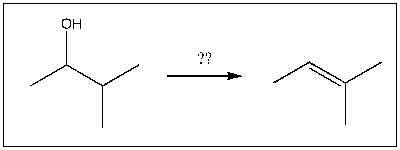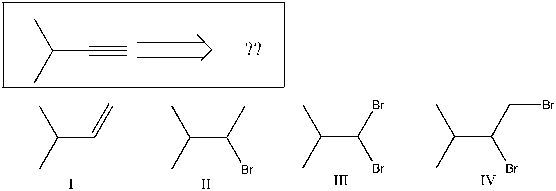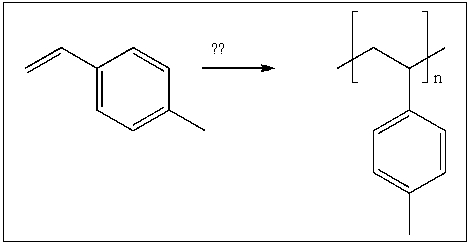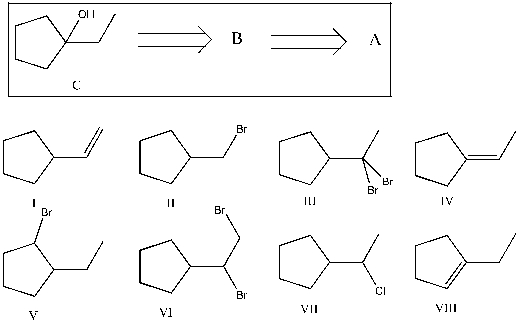A) 1) OsO4; 2) NaHSO3, H2O
B) 1) Hg(OAc) 2, H2O; 2) NaBH4
C) 1) RCO3H; 2) H3O+
D) H2SO4, H2O
E) 1) O3; 2) DMS
Correct Answer

verified
Correct Answer
verified
Essay
Devise a method to complete the following synthesis. 
Correct Answer

verified
Correct Answer
verified
Multiple Choice
For the transformation shown, select the most appropriate reagent(s) to effect the change. 
A) 1) OsO4; 2) NaHSO3, H2O
B) HBr, ROOR
C) NaBr
D) xs NaNH2
E) HBr
Correct Answer

verified
Correct Answer
verified
Multiple Choice
Which sequence of reagents will accomplish the following transformation? 
A) 1) KOtBu; 2) HBr
B) 1) NaOEt; 2) HBr, ROOR
C) 1) H2SO4, heat; 2) Br2, h
D) 1) NaOEt; 2) HBr
E) both A and D work
Correct Answer

verified
Correct Answer
verified
Multiple Choice
Which of the following provides an efficient method of converting 3-bromo-2-methyl-1-butene into 2-methyl-2-butene?
A) 1) NaOH; 2) H2, Pt
B) 1) H2, Pt; 2) NaOEt
C) 1) H2, Pt; 2) Br2
D) 1) H2, Ni2B; 2) KOtBu
E) 1) H2, Pt; 2) KOtBu
Correct Answer

verified
B
Correct Answer
verified
Essay
Devise a method of converting trans-2-methyl-3-hexene into 5-methylhexanal.
Correct Answer

verified
Correct Answer
verified
Short Answer
Propose a three-step synthetic sequence to accomplish the transformation below. 
Correct Answer

verified
1) TsCl 2)...View Answer
Show Answer
Correct Answer
verified
View Answer
Multiple Choice
Which of the following sequences most efficiently converts 3-methyl-1-pentene into 3-bromo-3-methylpentane?
A) 1) Br2; 2) NaOH; 3) HBr
B) 1) Br2, h ; 2) H2, Pt
C) 1) H2, Pt; 2) Br2, h
D) 1) NBS, h ; 2) H2, Pt
E) 1) HBr, ROOR; 2) NaOH; 3) HBr
Correct Answer

verified
Correct Answer
verified
Multiple Choice
Provide the major product(s) for the following transformation: 

A) I
B) II
C) III
D) IV
E) I and III
Correct Answer

verified
Correct Answer
verified
Multiple Choice
Which sequence of reagents will accomplish the following transformation? 
A) 1) KOtBu; 2) 1-bromopropane
B) 1) NaNH2; 2) 1-bromopropane
C) 1) NaNH2; 2) 2-bromopropane
D) 1) O3; 2) DMS
E) 1) O3; 2) 1-bromopropane
Correct Answer

verified
Correct Answer
verified
Multiple Choice
For the transformation shown, select the most appropriate reagent(s) to effect the change. 
A) NaOH
B) heat/H2SO4
C) CH3CO2H
D) NaOEt
E) KOtBu
Correct Answer

verified
Correct Answer
verified
Multiple Choice
Using retrosynthetic analysis, determine which compound(s) could lead to the alkyne shown below in a single step: 
A) I
B) II
C) III
D) IV
E) I or II
) I, II, or IV
Correct Answer

verified
Correct Answer
verified
Multiple Choice
For the transformation shown, select the most appropriate reagent(s) to effect the change. 
A) 1) OsO4; 2) NaHSO3, H2O
B) ROOR, heat
C) NaOH
D) xs NaNH2
E) 1) O3; 2) H2O
Correct Answer

verified
Correct Answer
verified
Multiple Choice
For the transformation shown, select the most appropriate reagent(s) to effect the change. 
A) 1) OsO4; 2) NaHSO3, H2O
B) 1) Hg(OAc) 2, H2O; 2) NaBH4
C) 1) RCO3H; 2) H3O+
D) 1) BH3-THF; 2) H2O2, NaOH
E) 1) O3; 2) DMS
Correct Answer

verified
Correct Answer
verified
Multiple Choice
Select the best reagent to convert 1-bromo-1-methylcyclohexane to 1-bromo-2-methylcyclohexane.
A) 1) KOtBu; 2) HBr
B) 1) NaOEt; 2) HBr
C) 1) NaOEt; 2) HBr, ROOR
D) 1) KOtBu; 2) HBr, ROOR
E) Br2, h
Correct Answer

verified
Correct Answer
verified
Multiple Choice
Show that you understand the concept of retrosynthetic analysis by working backwards two steps in the synthesis below. Identify possible combinations of A and B that can lead to the alcohol (C) : 
A) B = I and A = VI
B) B = VI and A = I
C) B = III and A = VII
D) B = VII and A = IV
E) B = VIII and A = V
Correct Answer

verified
Correct Answer
verified
Multiple Choice
Reaction of compound A (molecular formula = C12H24) with ozone followed by reaction with DMS produces only (CH3) 3CCH2CHO. Which of the following could be compound A?
A) cis-2,3,7,8-tetramethyloct-4-ene
B) trans-dodec-6-ene
C) 4,4-dimethylpent-1-ene
D) cis-2,2,7,7-tetramethyloct-4-ene
E) 2,2-dimethyldec-4-ene
Correct Answer

verified
Correct Answer
verified
Essay
Propose a three-step synthetic sequence to accomplish the transformation below. 
Correct Answer

verified
1) Conc. H...View Answer
Show Answer
Correct Answer
verified
View Answer
Multiple Choice
Starting with a primary alkyl bromide, which of the following results in an overall decrease in the length of the carbon skeleton by one carbon?
A) substitute bromide with acetylide, then cleave the triple bond.
B) substitute bromide with acetylide, then reduce the alkyne to an alkene.
C) substitute bromide with methoxide.
D) eliminate hydrogen bromide to produce an alkene, then cleave the double bond.
Correct Answer

verified
D
Correct Answer
verified
Essay
Propose an efficient method of converting 3-methyl-2-butanol into 3-methyl-1-butanol.
Correct Answer

verified
11eab459_a641_2e76_acdb_974ea06c9233_TB3185_00
Correct Answer
verified
Showing 1 - 20 of 95
Related Exams